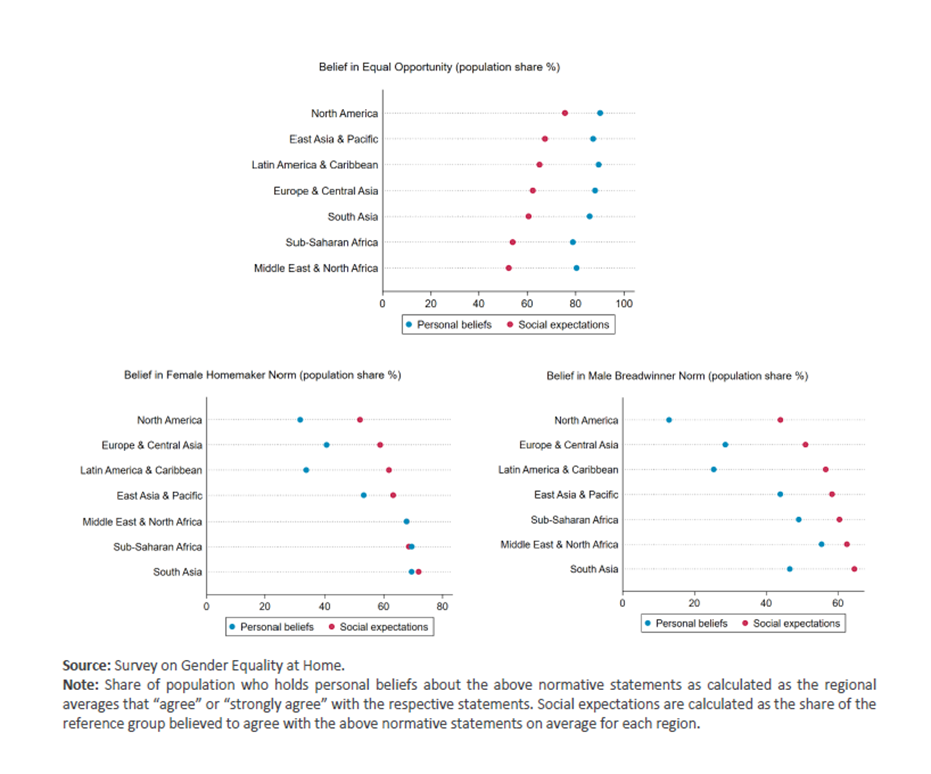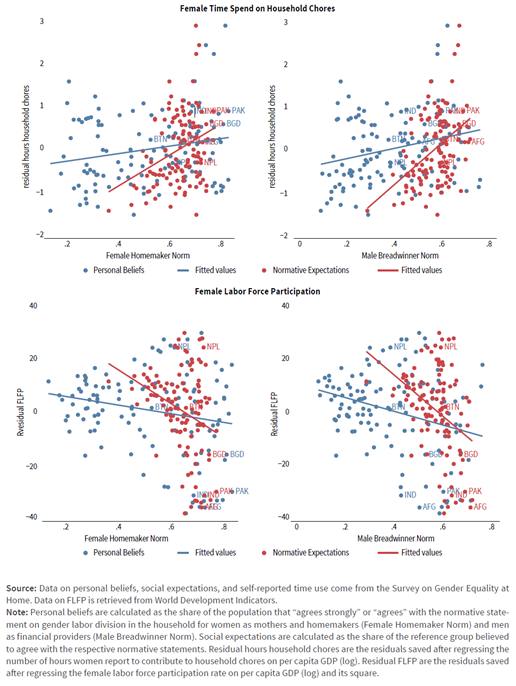Social Norms and Gender Equality in South Asia
by S Anukriti , Maurizio Bussolo , Jessy Amarachi Ezebuihe , Ana Maria Munoz Boudet , Tasmia Rahman , Nele Charlotte A Warrinnier , Anaise WilliamsMeta Gender
This blog highlights recent work from a larger body of research on gender equality carried out at the World Bank. The blog itself relies on Chapter 3 of this report South Asia Economic Focus Reshaping Norms: A New Way Forward.
Despite decades of rapid economic growth, rising education, and declining fertility, women in South Asia continue to face greater disadvantages in accessing economic opportunities than in most of the developing world. Some progress has been made but improvements are slow and increasing income levels do not seem sufficient to reduce stubbornly high gender gaps across multiple dimensions in the region. Social norms about gender can be a key obstacle towards gender equality and these norms are particularly biased against women in South Asia. Many jobs and occupations are considered “men’s jobs,” and few women cross over (World Bank 2022). This concentration of employment in a few (mainly service) sectors exposes women to large employment losses when a crisis hits these sectors. Mobility restrictions further limit women’s ability to work outside the home. Social norms hinder women’s access to land, financial capital, and other assets. They also limit households’ investment in women’s human capital, reducing access to higher education, and constrain women’s influence over decision making, inside and outside the home.
The COVID-19 crisis has exacerbated existing gender disparities in South Asia. Understanding the role of social norms in limiting women’s access to opportunities in South Asia has become more urgent.
Challenge
Social norms are a complex construct and often difficult to measure. Social norms are defined as informal rules of behaviour that dictate what is acceptable or appropriate to do in a given situation within a given social context (Bicchieri 2006). Individuals tend to conform to a norm—that is, act a certain way—if they believe that most individuals within the group they consider their reference network, both conform to the norm and believe that everyone should conform to the norm (Bicchieri 2017).
Social norms rely on individual perceptions of others, namely they have a social component. They are distinct from personal attitudes, morals, and beliefs as these are unrelated to perceptions of others (Cislaghi and Heise 2018). For attitudes and beliefs, the motivating factor—the imperative to follow a certain behaviour—is internal to the individual. In the case of social norms, the imperative is the external, or social, influence of others. Unlike attitudes, social norms comprise two components—perceptions about how frequent or typical a behaviour is within a particular reference. group (i.e., a “descriptive norm” or “social empirical expectation”), and perceptions about how a member of the group ought to behave (i.e., an “injunctive norm” or “social normative expectation”) (Bicchieri 2006, 2012; Cialdini et al. 1991).
Using early marriage as an example, table 1 shows a classification of beliefs (or expectations) according to whether they are social or not and whether they have or not a normative content. An early marriage social norm will exist in a specific society, or group within that society, if a large percentage of people share the same social belief about (a) what others do, and (b) what others think one should do. Unfortunately, most of the empirical work relies on non-social beliefs, the elements of the first column of Table 1. Without more precise measurements and data on the social elements, assessing how important the role of social norms is in explaining gender inequality is thus still quite imprecise (with few exceptions such as Gauri et al. 2019).

While personal attitudes can be useful proxies for social norms, the social elements of norms (what I think others believe in, and what I see others do, see table1) have been less explored.
A first step towards a solution
Facebook’s global Survey on Gender Equality at Home measures both personal beliefs, or attitudes, and the social expectations toward gender equality and gender roles. The distinction between personal attitudes and social expectations is important because assuming that the former is a close substitute for the latter may potentially lead to an underestimation of the strength of social norms and their impact on gender inequality.
The survey shows that social expectations of gender roles tend to be more conservative than individuals’ personal beliefs. Respondents were asked about their own agreement with various statements concerning the role of women in the household (personal beliefs) and how many, out of 10 neighbours (taken as a reference group), would agree with the same statements (social normative expectations). Specifically, respondents were asked to report how strongly they agree or disagree with the following statements (a) Equal Opportunity: “Men and women should have equal opportunities (e.g. in education, jobs, household decision-making),” (b) Female Homemaker norm: “Woman’s most important role is to take care of her home and children,” and (c) Male Breadwinner norm: “Household expenses are the responsibility of the man, even if his wife can help him.” Social expectations of the reference group are more conservative across all three statements compared to people’s own personal beliefs (Figure 1).
If the external pressure from the reference group matters for individuals’ behaviour, it is possible that, even in the presence of less restrictive personal beliefs, gender inequality persists. Compared to other regions, South Asian countries appear to have the most conservative social normative expectations around women’s and men’s roles within the household (see figure 1). This is consistent with the high levels of gender inequality in South Asia. In addition, for the specific case of “A woman’s most important role is to take care of her home and children” there is convergence between what people believe and what they assume others’ beliefs. In such a situation, ‘correcting’ the social normative expectations by informing individuals that society’s views are indeed less restrictive than individuals believe is not possible and the social norms may have a stronger hold in maintaining gender inequality.

Insights
Data from the survey can be used to test some of these hypotheses. They can be used, for example, to assess whether the correlation between gender outcomes and social normative expectations is stronger than that between gender outcomes and personal beliefs. Clearly, other factors influence gender outcomes. Economic development, or the level of GDP per capita, has strong correlations with women’s time use for household chores, paid employment, and labour force participation (Boserup, 1970; Durand 1975; Goldin 1995). Using regression analysis, we can gauge the correlations of gender outcomes and social norms once the influence of GDP per capita has been controlled for. In other words, we can assess whether more conservative social norms—and, separately, for the social normative expectations and the personal beliefs component—are associated with worse gender outcomes in countries that are at the same level of development. The results of this analysis are shown in figure 2. Three main insights are highlighted: i) Social norms matter; this is because the ‘residual’ or how much more or less time women spend on household chores or in the labour market compared to women in countries with the same level of development is significantly correlated with social norms; ii) Social normative expectations matter more than personal beliefs; this is because the slope of the regression lines in the figures is steeper for social normative expectations than personal beliefs; iii) Social norms matter a lot in South Asia; this is because South Asian countries tend to have large residuals (for example, female labour force participation is 15 percent lower compared to equally developed countries) and restrictive social norms.

More results on the quantification of the links between social norms and gender outcomes can be found in chapter 3 of “World Bank (2022). Reshaping Norms: A New Way Forward. South Asia Economic Focus, Spring 2022. Washington, DC: World Bank”. The chapter also shows the norms-blindness of policies addressing the low female labor force participation rate in South Asia and pushes for a shift in incentives to change norms. Data such as those of the Facebook’s Survey on Gender Equality at Home can provide guidance in designing these incentives.